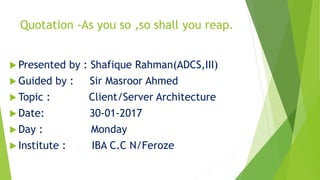
Client/Server Architecture Explained in Detail
- 1. Quotation -As you so ,so shall you reap. Presented by : Shafique Rahman(ADCS,III) Guided by : Sir Masroor Ahmed Topic : Client/Server Architecture Date: 30-01-2017 Day : Monday Institute : IBA C.C N/Feroze
- 3. PROCESS-TO-PROCESS DELIVERY The data link layer is responsible for node-to-node delivery. The network layer is responsible for host-to-host delivery. Communication on the Internet is not defined as the exchange of data between two nodes or between two hosts. Real communication takes place between two processes (application programs). We need process-to-process delivery. However, at any moment, several processes may be running on the source host and several on the destination host.
- 4. PROCESS-TO-PROCESS DELIVERY To complete the delivery, we need a mechanism to deliver data from one of these processes running on the source host to the corresponding process running on the destination host. The transport layer is responsible for process-to-process delivery-the delivery of a packet. As we will see later.
- 5. Client/Server Paradigm or Architecture Although there are several ways to achieve process-to- process communication. The most common one is through the client/server paradigm. A process on the local host, called a client, needs services from a process usually on the remote host, called a server. Both processes (client and server) have the same name. For example, to get the day and time from a remote machine, we need a Daytime client process running on the local host and a Daytime server process running on a remote machine.
- 6. Client/Server Paradigm or Architecture Operating systems today support both multiuser and multiprogramming environments. A remote computer can run several server programs at the same time, just as local computers can run one or more client programs at the same time.
- 7. Client/Server Paradigm or Architecture For communication, we must define the following: 1. Local host 2. Local process 3. Remote host 4. Remote process
- 8. Addressing Whenever we need to deliver something to one specific destination among many, we need an address. At the data link layer, we need a MAC address to choose one node among several nodes if the connection is not point-to- point. A frame in the data link layer needs a destination MAC address for delivery and a source address for the next node's reply.
- 9. Addressing At the network layer, we need an IP address to choose one host among millions. A datagram in the network layer needs a destination IP address for delivery and a source IP address for the destination's reply. At the transport layer, we need a transport layer address, called a port number, to choose among multiple processes running on the destination host. The destination port number is needed for delivery; the source port number is needed for the reply. In the Internet model, the port numbers are 16-bit integers between 0 and 65,535.
- 10. Addressing The client program defines itself with a port number, chosen randomly by the transport layer software running on the client host. This is the ephemeral port number. The server process must also define itself with a port number. This port number, however, cannot be chosen randomly. The Internet uses universal port numbers for servers; these are called well-known port numbers.
- 11. Addressing For example, while the Daytime client process, discussed above, can use an ephemeral port number 52,000 to identify itself, the Daytime server process must use the well-known (permanent) port number 13. Following Figure shows this concept.
- 12. Daytime client daytime server DD52,000 13 Data 13 52,000 Transport layer Transport layer DD
- 13. Addressing It should be clear by now that the IP addresses and port numbers play different roles in selecting the final destination of data. The destination IP address defines the host among the different hosts in the world. After the host has been selected, the port number defines one of the processes on this particular host
- 14. lANA Ranges The lANA (Internet Assigned Number Authority) has divided the port numbers into three ranges: Well known ports-The ports ranging from 0 to 1023 are assigned and controlled by lANA. Registered ports-The ports ranging from 1024 to 49,151 are not assigned or controlled by lANA. They can only be registered with lANA to prevent duplication. Dynamic (or private) ports-The ports ranging from 49,152 to 65,535 are neither controlled nor registered. They can be used by any process. These are the ephemeral ports.
- 15. IP addresses versus port numbers IP header IP address selects the host Port number selects the process
- 16. Socket Addresses Process-to-process delivery needs two identifiers, IP address and the port number. The combination of an IP address and a port number is called a socket address. The client socket address defines the client process uniquely. The server socket address defines the server process uniquely
- 17. Socket Addresses A transport layer protocol needs a pair of socket addresses: The client socket address The server socket address These four pieces of information are part of the IP header and the transport layer protocol header.
- 18. Figure : Socket address
- 19. Multiplexing and Demultiplexing Processes Processes
- 20. Happiness of your life depends upon quality of your thoughts. I hope you enjoyed my presentation.
